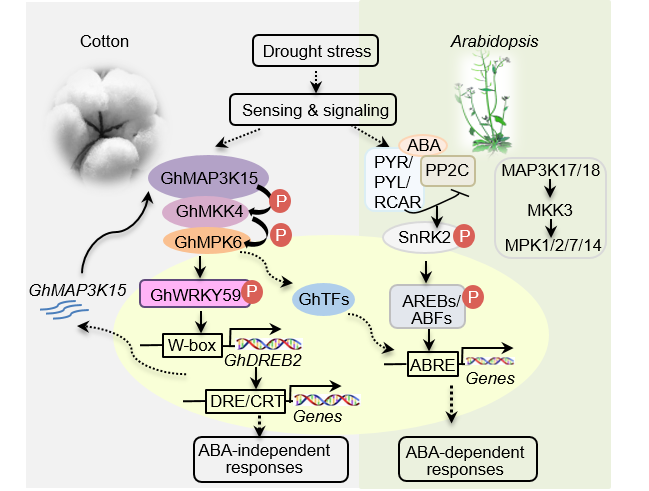With global climate change, the tension between crop production and water supply is intensifying, and drought stress is a prominent limiting factor to crop production. This problem is particularly important to cotton since more than half of global cotton production is from high water stress areas. Water deficit not only reduces the cotton yield stability and fiber quality, but also aggravates soil-borne pathogen diseases. We have identified a mitogen-activated protein kinase (MAPK) cascade that phosphorylates and activates a key WRKY transcription factor in controlling cotton drought response. We also revealed the role of ADP-ribosylation in cotton drought stress regulation. We aim to understand the mechanisms and the intertwined crosstalk of protein phosphorylation and ADP-ribosylation in orchestrating cotton drought stress responses, and provide a strategy to genetically and biochemically rewire cotton water use efficiency.
Drought stress activates a MAPK cascade consisting of GhMAP3K15-GhMKK4-GhMPK6, which further phosphorylatesGhWRKY59 in cotton. See New Phytologist (2017) 215:1462.
Key references:
- Lahiri, A., Zhou, L., He, P., Datta, A. Detecting drought regulators using stochastic inference in Bayesian networks (submitted).
- Mu, C., Zhou, L., Shan, L., Li, F., and Li, Z. (2019) Phosphatase GhDsPTP3a interacts with annexin protein GhANN8b to reversely regulate salt tolerance in cotton (Gossypium spp.). New Phytologist 223: 1856-1872.
- Li, F., Li, M., Wang, P., Cox, K. L., Duan, L., Dever, J.K., Shan, L. Li, Z., and He, P.(2017)Regulation of cotton drought responses by a MAP kinase cascade-mediated phosphorylation of GhWRKY59. New Phytologist 215: 1462-1475.

